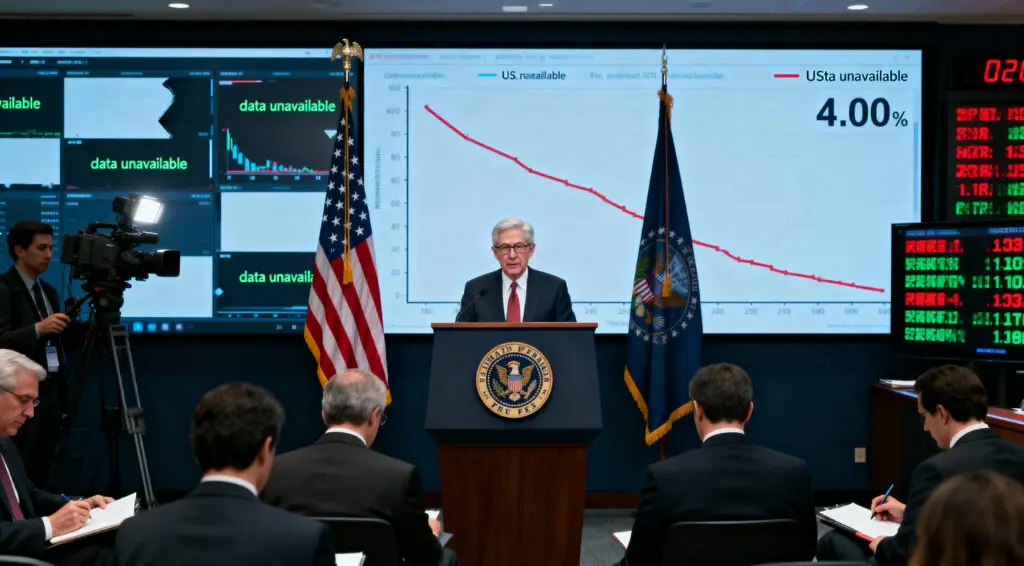Fed Faces Data Void as Shutdown Disrupts Economic Reports
The US Federal Reserve is preparing to announce its second interest rate cut of 2025 despite limited visibility into the economy due to a prolonged government shutdown. The suspension of official data releases has forced policymakers to make key decisions with partial information, raising uncertainty about the true state of inflation and employment.
The standoff between Republicans and Democrats over health care subsidies has halted most government data publications, complicating the Fed’s ability to gauge growth and price pressures. Analysts still expect a quarter-point cut, lowering the federal funds rate to between 3.75% and 4.00%.
Debate Within the Fed Over Inflation and Labor Support
Fed officials remain divided on whether to prioritize supporting a softening labor market or curbing persistent inflation. Consumer prices remain above the Fed’s 2% target, driven partly by the Trump administration’s broad tariffs on major trading partners.
Joseph Gagnon, a former Fed official, noted that the key challenge lies in determining whether inflationary pressures have peaked or remain embedded. The Fed’s dual mandate to maintain price stability and full employment leaves policymakers walking a fine line between over-tightening and underreacting.
Treasury Secretary Bessent Predicts Inflation Decline
Treasury Secretary Scott Bessent has expressed optimism that inflation will soon ease. In an interview with NBC’s “Meet the Press,” he attributed the affordability crisis to the previous administration but said price growth is expected to fall back toward the 2% target in the coming months.
The latest inflation report, delayed due to the shutdown, showed consumer prices rising 3.0% year-over-year in September—slightly below forecasts. The lower reading buoyed investor confidence, helping push financial markets to record highs.
Recommended Article: Lucy Powell Elected Labour Deputy Leader After Tight Race
Mixed Signals From Employment and Growth Indicators
Employment data before the shutdown showed slowing job creation, with only 22,000 new jobs in August, while unemployment remained near historic lows at 4.3%. The lack of fresh labor data leaves policymakers uncertain about whether the economy is cooling or merely stabilizing after a strong midyear rebound.
Economist Diane Swonk of KPMG described the Fed’s position as “trying to get it just right with a blunt tool,” suggesting that further cuts may be necessary. Swonk expects two additional rate reductions before year-end and an early end to quantitative tightening to ease liquidity stress.
Political Pressures Add Complexity to Fed Decision
The Federal Reserve’s independence has come under renewed political pressure from President Donald Trump, who has frequently criticized Chair Jerome PowellWeek in Politics Trump, Putin, and Powell on social media. Powell, whose term ends next year, has faced calls for resignation alongside legal challenges aimed at removing Fed Governor Lisa Cook.
The Supreme Court is set to hear arguments in Cook’s case in January 2026, with a decision unlikely before February. The outcome could influence the Fed’s internal governance and policy direction as it prepares for leadership transitions and regional president reappointments.
Balancing Risks as Year-End Approaches
As the Fed heads into its final policy meetings of 2025, the central bank faces the difficult task of sustaining growth while steering inflation toward target. The lack of comprehensive data makes forecasting more uncertain, and any misstep could heighten volatility in financial markets.
While most economists expect the Fed to proceed with rate cuts, the broader economic picture remains murky. Until the government reopens and full data transparency returns, monetary policy decisions will rely heavily on limited indicators and market sentiment, leaving investors on edge ahead of December’s final meeting.























